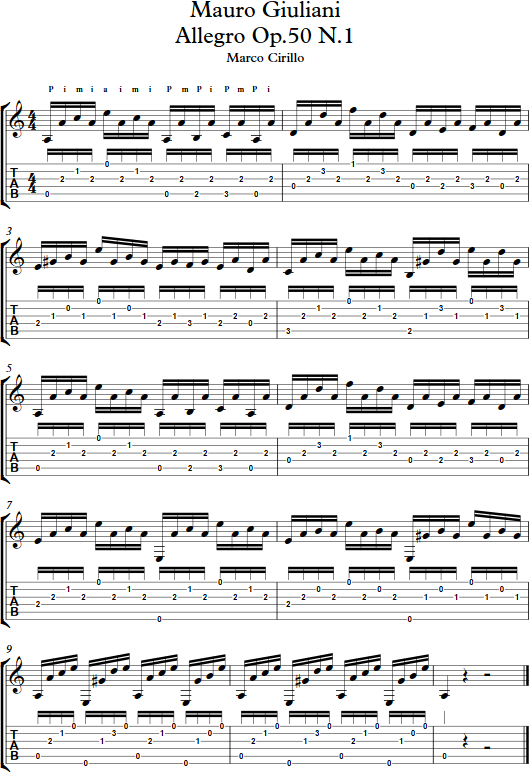Fingerstyle Classical Guitar Lesson
Mauro Giuliani Allegro Op.50 N.1
Hey guys, today I will show you how to play this awesome fingerstyle classical guitar piece that can be played on both classical and acoustic guitar.
The piece is called Allegro, and Mauro Giuliani composed it at the beginning of 1800.
It’s a composition in A minor featuring the famous Giuliani fingerstyle arpeggio, and it is one of the most famous pieces that beginners play on classical and acoustic guitar.
You can get the tab and the video lesson here!
Let’s get started.
Mauro Giuliani Allegro Guitar Lesson
I probably recorded this piece a little bit too fast. Now that I am listening to it, I feel like it’s a little bit too fast, so please, don’t refer to this speed. You can play it way less fast and still be effective and awesome to play.
Right Hand
The fingerstyle pattern used in this fingerstyle classical guitar piece is one of the most famous and used in classical guitar. Mauro Giuliani is a master of this music style, and you will find this type of arpeggios quite a lot in his compositions.
Let’s break it down into a few sections so that you can easily learn it.
There are two different right-hand arpeggios in this song.
- The Red square is the arpeggio played at the beginning of each bar and is the song’s main fingerstyle pattern. It goes as follows: Thumb, index, middle, index, ring, index, middle, and index. You can also write this arpeggio like that: P i m i a i m me. It would help if you always put more emphasis on the 1st and 5th notes.
- Yellow Square is much easier to play. You will play a very defined melody with the thumb, followed by a pedal note on the top string. Here the plucking pattern is pretty simple, and it goes as follow: P m P i (Thumb, middle, Thumb, index)
I highly recommend you practice this fingerstyle classical guitar pattern slowly and over one chord only before moving on to the next position.
There are a ton of fingerstyle exercises you can do to improve your technique. Check out some of them here.

Left Hand
Chords and Dexterity Improvement
Let’s talk about the left hand and how to play chords and improve your finger’s dexterity.
The chord progression is straightforward, and it goes as follow:
Am – Dm – E – Am – E – Am – Dm – E – Am/E – Esus – E – Am
All the chords are played in position one and will be simple to memorize as they are quite repetitive.
For each chord you are playing there, most of the time, there will be a response on the next bar with a melody on the bass note and a pedal on the top. This only occurs over the first 12 bars right before the coda.
If you struggle with the chord change, I recommend practicing the chord separately without the right-hand arpeggio. Play the chords in pairs for a few minutes before moving on to the next pair.
After the chord change improves, put the chord progression together and add the fingerstyle classical guitar arpeggio that goes with the piece.
Be patient and practice one thing at a time.
Control over speed.
Mauro Giuliani Allegro Guitar Tab
Free Guitar Sheet Music
Final Thoughts
Mauro Giuliani Allegro is one of the best fingerstyle classical guitar arpeggios you will find. This short piece of music has been played millions of times and has helped thousands of guitar players.
Fingers dexterity is one of the most important aspects of your guitar playing, and you should always spend part of your guitar practice working on pieces and exercises that can improve it.
I prefer practicing my fingerstyle technique (and my left hand) with a practical song just like this one. Still, you can also implement a ton of fingerstyle exercises in your playing that is less musical and more mechanical.
You can find a lot of guitar lessons online and interact with a guitar teacher every month.
Everything is good and helpful as long as you keep consistency in your guitar practice.
Take things to step by step and improve your fingerstyle guitar playing.
Good luck, guys.
